Mar 31, 2014 | Baltimore, coins, quarter, shows, tokens
As with every show I attend, I try to find something neat. Something a little different. Something to show you that you can enjoy collecting numismatics that do not have to be plugged into a blue folder, a brown album, or entombed in a plastic case by a grading service. These are great items that have meaning and, for the most part, are affordable.
My find from the Spring 2014 Whitman Baltimore Expo was not discovered while walking the bourse floor. It was an opportunity that came available during the board meeting for the Maryland State Numismatic Association. One of our Board members is Ed Craig who is also president of the Maryland Token and Medals Society. As part of the meeting, Ed showed a limited edition elongated quarter that Maryland TAMS produced to commemorate the 200th Anniversary of the Battle of Baltimore and the writing of the poem “The Defence of Fort McHenry” by Francis Scott Key.
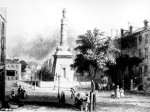
An 1838 lithograph of the Battle Monument in Baltimore
When they rolled the quarter to create the design, it was imprinted on the obverse of the quarter. You can see the Fort McHenry quarter design through the flattened reverse.
I will be wearing the one I purchased this August at the World’s Fair of Money in Chicago.
Maryland TAMS is making a very limited number of these sets available for $10 each. If you cannot pick up your set, they will ask you to pay postage to mail it to you. If you are interested contact Maryland TAMS through their website at mdtams.org.

Cover of the Maryland Token and Medal Society souvenir card.

Cover of the Maryland Token and Medal Society souvenir card.
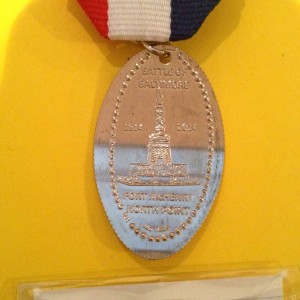
Closeup of the elongated quarter that is part of the Maryland Token and Medal Society souvenir card.

Back cover of the Maryland Token and Medal Society souvenir card.
Click on images to see larger versions.
Oct 21, 2013 | coins, pocket change, quarter
Over the last few years I have been trying to come to grips with the aging process. I waited a few years before joining AARP, I spent the time to take care of health issues, and I even took to heart an article written for the AARP magazine that asks what I want to be when I grow up (which I will write about another time). Looking back, my return to my collecting interests was the beginning of what would blossom into a full blown mid-life crisis.
I decided to give into my mid-life crisis and as long as it does not affect much, my wife is letting me go.

L-R: 1970 Dodge Challenger and a 1971 Dodge Challenger convertible are still desired American muscle
I have always had an appreciation for the cars built prior to 1980. Actually, with few exceptions, I enjoy seeing all cars built prior to 1978, about the time that cars became bland. Exceptions are the Corvettes made any time and the new Dodge muscle cars particularly a Dodge Challenger R/T Classic.
By now you are probably asking what this has to do with coins, other than it will take a lot of them to buy a car?
This past weekend I attended the annual Rockville Antique and Classic Car Show. With more than 60 cars and motorcycles, it has to be one the larges classic car show at least in this region. Anyone who loves old cars will feel like a kid on a playground when you climb over the hill into the field. This is the same show that I found the Plymouth Gold Duster brochure advertising the “Old West” Coin Collection last year. While I did not find anything this year, I did have an encounter with classic coins in a classic car.
I was looking in a 1951 Hudson Hornet (here is the information about Jay Leno’s Hornet to see what a Hornet looks like since my camera died by then) and saw change in the ashtray. I asked the owner about the coins and he said that they were found in the car when he bought it from someone’s barn over 10 years ago. After he finished restoring the car he put the change into the ashtray for effect.

This 1927 Standing Liberty Quarter is similar to the one I found in the Hornet’s ashtray.
One of the problems was that he cleaned the coins. Apparently, they were so encrusted with junk and dirt that he thought that cleaning them would be a good idea. While both coins are quite common even if they were not cleaned, whatever value they had was reduced by the harsh cleaning. The silver coins are minimally worth their value in silver.
The car’s owner asked me to write down the information and returned the coins to the ashtray. I left him with some web links including a link to this blog. He asked me not to use his name and I hope he had a good time at the show. I know I did!
If you want to see the pictures I did take at the Rockville auto show, you can see the pictures on Photobucket.
Image of the 1927 Standing Liberty Quarter courtesy of
MPG Coins. The coin is for sale on their site.
Sep 22, 2013 | celebration, coins, national park quarters, quarter, US Mint
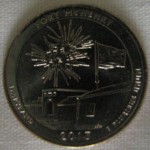 On Monday, September 12, 1814 the British invasion fleet landed at North Point in Baltimore and tried to capture Baltimore by attacking Fort McHenry. Before the attack on Baltimore, the British marched through Washington, D.C. and burned the capital building. On their march to Baltimore, the British took Dr. William Beanes as a prisoner for his role in capturing British stragglers and deserters. Beanes was imprisoned in Baltimore as the Royal Navy gathered forces for their attack on Fort McHenry in Baltimore Harbor.
On Monday, September 12, 1814 the British invasion fleet landed at North Point in Baltimore and tried to capture Baltimore by attacking Fort McHenry. Before the attack on Baltimore, the British marched through Washington, D.C. and burned the capital building. On their march to Baltimore, the British took Dr. William Beanes as a prisoner for his role in capturing British stragglers and deserters. Beanes was imprisoned in Baltimore as the Royal Navy gathered forces for their attack on Fort McHenry in Baltimore Harbor.
Word of Beanes’s capture reached Francis Scott Key, an accomplished lawyer, prosecutor, poet, and friend of Dr. Beanes. Key, who was known as a skilled negotiator and a very temperate man, was asked by the Army to accompany prisoner exchange agent Colonel John Stuart Skinner to Baltimore to secure the release of Dr. Beanes. On September 7, 1814, Key and COL Skinner dined with British officers abroad the HMS Tonnant to negotiate the release of prisoners. Although Beanes was released, the British would not let the men leave the ship because they had heard about the British plans to attack Fort McHenry.
Key, Skinner, and Beanes watched as the Royal Navy bombarded the fort and surrounding areas of Baltimore. As the smoke cleared on the morning of September 14, 1814, after 25-hours of bombardment, Key was able to see the U.S. flag still flying over Fort McHenry. Key was so moved by the sight that after returning home, he wrote the poem “The Defence of Fort McHenry.” The poem was published in the Baltimore Patriot on September 20, 1814.
Following the War of 1812, Baltimoreans celebrated the victory every year on September 12 but did not gain statewide recognition until the centennial celebration in 1914, even though the celebration was overshadowed by World War I. Celebrations waned during the Great Depression until it became an official holiday in 1957. Defenders Day would become popular again in the 1980s with the help of the National Park Service and the Fort McHenry Guard.
-

-
Obverse of the Fort McHenry Commemorative Medallion for sale at the gift shop.
-

-
Reverse of the Fort McHenry Commemorative Medallion for sale at the gift shop.
This year, Defenders Day was celebrated on Friday, September 13. With a crowd of area students, area residents, dignitaries, and members of the Maryland State Numismatic Association, the Defenders Day celebration kicked off at Fort McHenry with the launch ceremony of the Fort McHenry National Monument and Historic Shrine quarter.
With Ranger Bailey as the master of ceremonies, the program features Park Superintendent Tina Cappetta, Maryland Senator Ben Cardin (D), Representative John Sarbanes (D) whose district includes Fort McHenry, Representative C.A. “Dutch” Ruppersberger (D) whose district covers parts of Baltimore not in Sarbanes’ district, Baltimore Mayor Stephanie Rawlings-Blake (D), and Treasurer of the United States Rosie Rios.
Speeches were interspersed with a performance from the Notre Dame Prep (Towson, MD) Choir, ceremonial drills from the Fort McHenry Guard, and the Fort McHenry Fife and Drum Corps. Prior to end of the ceremony, Treasurer Rosie Rios presented a special plaque with examples of the Fort McHenry Quarters to Superintendent Cappetta.
The ceremony ended with the dignitaries on the stage pouring a bucket of quarters into a old ammunition box.
Following the ceremony the dignitaries handed out quarters to to the students who sat through the ceremony. These children were attentive and appreciative of the ceremony and the quarter.
Clearly, the most popular person giving out quarters was Mayor Rawlings-Blake of Baltimore. Rawlings-Blake is a native of Baltimore, mother, and younger than the other politicians in attendance. It was clear that she connected better with the students than the other politicians.

Fort McHenry Quarters display folder issued by the National Park Service
On my way out of the park, I made the obligatory stop in the gift shop. Surrounded by students having fun looking at the items for sale, I found a card issued by the National Park Service with the Fort McHenry quarters commemorating the fort. The back of the card says that a portion of the proceeds are donated to the National Park Conservation Alliance. I also purchased a commemorative medal with a hologram on both sides. The images on the obverse commemorate the Star-Spangled Banner while the reverse shows the fort.
Not a bad way to spend the morning in Baltimore before having to return to work.
All images owned by the author.
Jan 25, 2010 | coin design, history, national park quarters, quarter
While catching up on the weekend’s reading I came across an article Debate rages in coin world: Theodore Roosevelt or George Washington on new quarter? The article is about how the Citizens Coinage Advisory Committee debated whether to recommend that Teddy Roosevelt be placed on the obverse of the new America the Beautiful Quarters.
Introduced in 1932, the Washington Quarter was intended to be issued as a one-time circulating commemorative to honor the 200th anniversary of George Washington’s birth. The quarter was born of controversy when Secretary of the Treasury Andrew Mellon chose John Flanagan’s depictions over what had been determined to be a more artistic version by Laura Gardin Fraser. Although Mellon was a collector of great fine art that was later donated to the National Gallery of Art, many knew he was a sexist and refused to consider that a woman’s work was better than a man’s.
As the Great Depression deepened, no quarters were struck in 1933. Toward the end of the year, US Mint director Nellie Tayloe Ross was asked by the Federal Reserve to produce more quarters for circulation. Rather than use a new design, Ross ask the Treasury Secretary William Woodin for permission to continue to use Fraser’s design. Since Ross and Woodin did not want to undergo a new design competition, the Fraser designed continued until it was “updated” in 1999 for the 50 State Quarters Program.
Numismatist see Teddy Roosevelt as the father of the coinage renaissance when he tried to conspire with Augustus Saint-Gaudens to bring classic design to American coinage. Roosevelt call this his Pet Crime. Roosevelt was instrumental in the Mint using Saint-Gauden’s designs for the $10 gold eagle and his famous design on the $20 gold double eagle coin that continues to be celebrated today. Add the wonderful work by Bela Lyon Pratt on the gold quarter and half eagle coins along with Victor David Brenner’s Lincoln cent and the stage was set for a period of timeless classics.
Under his presidency, Roosevelt made conservation a national priority. He placed more land into the public trust than any other president and created the US Forest Serive to care for that land. Roosevelt elevated the importance of the National Park Service to be more than a caretaker of public land but make it accessible to everyone while protecting its beauty. His service to conservation has not been matched by any president since.
With his work on coinage and the lands that will be featured on the new series, it would be a natural recommendation to have Roosevelt adorn the obverse of these quarter. However, the article reports that the CCAC backed down because of the alleged lack of support by congress.
The CCAC is supposed to be an independent organization that is supposed to recommend what is best for the design of American coinage. It is supposed to be a non-partisan and non-political organization that apparently succumbed to the politics of the day. Rather than doing what is right, the CCAC wilted at the chance to refresh the sameness of the one coin’s design in the same way that Roosevelt bristled at the designs of Charles Barber in the early 20th century.
I am sure that members of the CCAC will ask that if there is no support for the design then why propose it? Because at some point, it is more important to do the right thing than taking the politically expedient path. It would put congress on record as being against a populist idea, albeit a small population of populists. It would show that the CCAC was an organization that understand the issues of coin design and not a rubber stamp body of sometimes bland coin designs.
The CCAC must re-evaluate their role as and advisory committee and advise. If this is not possible, then the CCAC only duplicates the role of the Commission of Fine Arts and should be disbanded.
Dec 26, 2009 | cents, coins, commemorative, dollar, quarter, US Mint
Around this time last year, I wrote that 2009 would be quite a year. As 2009 comes to an end, I know why I am not a prognosticator. With the down economy, the convergence of so many coin programs, and the performance questions of the US Mint it is difficult to call 2009 a successful year; yet it was not a failure.
Some of the success of this year included the 2009 Ultra High Relief Gold Coin, the District of Columbia and US Territories Quarters, and the Lincoln Bicentennial One Cent program. Although finding the cents and quarters have been difficult to find in change, these new coins had nice designs and was a chance for people to learn about Lincoln’s life and the history of our territories.

 As the Lincoln Cent enters its 101st year of production, it will be given a new reverse. The Union Shield was selected as the symbol of a united country. The shield is featured in many of the frescos painted by Constantino Brumidi throughout the US capitol. Brumidi was the Artist of the capitol during Abraham Lincoln’s presidency. The fresco shown here is one of the eight trophy panel from room S-128 (from the Senate side) of the capitol. It was design by Brumidi and painted by English artist James Leslie.
As the Lincoln Cent enters its 101st year of production, it will be given a new reverse. The Union Shield was selected as the symbol of a united country. The shield is featured in many of the frescos painted by Constantino Brumidi throughout the US capitol. Brumidi was the Artist of the capitol during Abraham Lincoln’s presidency. The fresco shown here is one of the eight trophy panel from room S-128 (from the Senate side) of the capitol. It was design by Brumidi and painted by English artist James Leslie.
Starting in 2010, the US Mint will begin the American the Beautiful Quarters Program. It will be a program with 56 quarter-dollar coins featuring designs depicting national parks and other national sites. Although this program might be overkill, the designs show that the program has the promise to show new and interesting designs. The first five quarters for 2010 will honor Hot Springs National Park in Arkansas, Yellowstone National Park in Wyoming, Yosemite National Park in California, Grand Canyon National Park in Arizona, and Mount Hood National Forest in Oregon. It will be interesting to see if this program will catch on.
 In the second year of the Native American $1 Coin program, the theme for the 2010 reverse is “Government–The Great Tree of Peace.” The reverse design features five bound arrows and the Hiawatha Belt. Hiawatha was the helper to the Great Peacemaker who negotiated peace amongst the Seneca, Cayuga, Onondaga, Oneida, and Mohawk tribes in the area now known as New York state. The alliance was known as Haudenosaunee, the Iroquois Confederacy, and is featured on the reverse. The words “Great Law of Peace” is also on the reverse to honor the constitution that created the confederacy. It is a wonderful design that follows up the great design of 2009.
In the second year of the Native American $1 Coin program, the theme for the 2010 reverse is “Government–The Great Tree of Peace.” The reverse design features five bound arrows and the Hiawatha Belt. Hiawatha was the helper to the Great Peacemaker who negotiated peace amongst the Seneca, Cayuga, Onondaga, Oneida, and Mohawk tribes in the area now known as New York state. The alliance was known as Haudenosaunee, the Iroquois Confederacy, and is featured on the reverse. The words “Great Law of Peace” is also on the reverse to honor the constitution that created the confederacy. It is a wonderful design that follows up the great design of 2009.
Continuing the Presidential $1 Coins, 2010 will include coins for Presidents Millard Fillmore, Franklin Pierce, James Buchanan, and Abraham Lincoln. We may see an increase of interest in these coins with the introduction of the dollar honoring Lincoln as we pass the (ho-hum) early 19th century presidents.
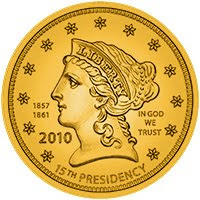 Along with the Presidential dollars will be the First Spouse Gold Coins. Along with the presidents will be gold coins to honor Abigail Fillmore, Jane Pierce, Buchanan’s Liberty, and Mary Todd Lincoln. President James Buchanan was not married. His first spouse coin will be a reproduction of the Liberty Head Quarter Eagle designed by Christian Gobrecht minted and issued from 1840 through 1907. The reverse design depicts the future President as a boy working as a bookkeeper in his family’s small country store design by Artistic Infusion Program Associate Designer David Westwood.
Along with the Presidential dollars will be the First Spouse Gold Coins. Along with the presidents will be gold coins to honor Abigail Fillmore, Jane Pierce, Buchanan’s Liberty, and Mary Todd Lincoln. President James Buchanan was not married. His first spouse coin will be a reproduction of the Liberty Head Quarter Eagle designed by Christian Gobrecht minted and issued from 1840 through 1907. The reverse design depicts the future President as a boy working as a bookkeeper in his family’s small country store design by Artistic Infusion Program Associate Designer David Westwood.
To round out circulating coinage, no changes are in store for the nickel, dime, and half-dollar.
Commemorative coins for 2010 will include the 2010 Boy Scouts of America Centennial Commemorative Coin and the American Veterans Disabled for Life Commemorative Coin. The Boy Scout commemorative celebrates the 100th anniversary of the Boy Scouts of America. The program will produce 350,000 silver dollar coins with the $10 surcharge will be paid to National Boy Scouts of America Foundation who issues grants to local council for the extension of scouting in hard-to-serve areas.
The American Veterans Disabled for Life will also produce 350,000 silver dollars in proof and uncirculated version to honor disabled veterans. The $10 surcharge will be paid to the Disabled Veterans’ LIFE Memorial Foundation to support the construction of the American Veterans Disabled for Life Memorial in Washington, DC.
Considering what happened this year, it will be difficult to predict what will happen to the American Eagle Bullion and American Buffalo 24-Karat Gold coins. Because of how the law is written, American Eagle bullion will be produced but we are not sure whether American Eagle proof coins will join them. I hope the proof coins will be produced in 2010, but with the current Mint administration, we will not know until they announce a commitment to their production.
I hope 2010 sizzles as much as 2009 fizzled!
Fresco image from Constantino Brumidi: Artist of the Capitol.
Coin images courtesy of the US Mint.
Sep 12, 2009 | quarter, US Mint
On Wednesday, the US Mint announced the America the Beautiful Quarter Series, a 56 quarter series to “honor” national parks in the 50 states, District of Columbia, and territories. As part of the announcement, the US Mint announced the schedule of the national parks and historic areas that will be depicted.
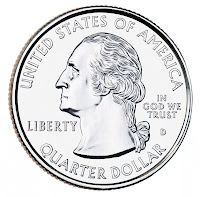 According to the US Mint, a “restored” version of the 1932 portrait of George Washington designed by John Flanagan. Either this could mean that the Mint engravers will either fix the “spaghetti hair” portrait of the 50 State Quarters or change it to resemble linguini.
According to the US Mint, a “restored” version of the 1932 portrait of George Washington designed by John Flanagan. Either this could mean that the Mint engravers will either fix the “spaghetti hair” portrait of the 50 State Quarters or change it to resemble linguini.
Pardon me if I fail to show excitement.
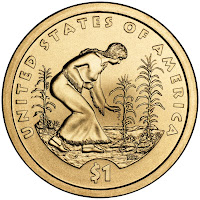 We just finished the State Quarters program and had the DC and Territories Quarters added to the end. This year we celebrate the bicentennial of Abraham Lincoln’s birth and the century anniversary of the Lincoln Cent. The Presidential $1 Coin series is in the middle of some of the dullest presidents in US history. And we cannot forget the Native American $1 Coin that probably has the best reverse design of all 2009 coins. Including the circulating coins without rotating reverses the total is 18 different coins being struck this year.
We just finished the State Quarters program and had the DC and Territories Quarters added to the end. This year we celebrate the bicentennial of Abraham Lincoln’s birth and the century anniversary of the Lincoln Cent. The Presidential $1 Coin series is in the middle of some of the dullest presidents in US history. And we cannot forget the Native American $1 Coin that probably has the best reverse design of all 2009 coins. Including the circulating coins without rotating reverses the total is 18 different coins being struck this year.
I agree with Mike Zielinski when he wrote on the Coin Update blog:
Although I did enjoy the 50 State Quarters series, I think reusing the same concept over and over again becomes dull. With no disrespect to the sites selected for the impending quarter series, I would rather see a single design that could become an iconic and lasting symbol of our generation [rather] than another collection of 56 designs representing 56 different things.
Let’s think of these quarters as a stimulus package for the collecting suppliers who will sell new folder and albums to house the coins in this series.
Below is the B-roll provided by the US Mint. Starting around 2:23 of the clip are scenes from within one of the branch mints showing the production of quarters.
Mar 14, 2009 | cents, coins, dollar, quarter
I went to my bank and branches of three other banks to look for rolls of Martin Van Buren dollars and Lincoln Birth and Early Childhood cents. I know that the William Henry Harrison dollars are the current issue, but I was not able to find Van Buren dollars when they were in active release.
One bank I went to had just emptied the cent bags from its coin counting machine. The teller showed me the three bags of cents that will be sent to their contractor to be counted and sent back to the Federal Reserve. They did have Harrison Dollars and some John Quincy Adams dollars, but no Van Burens. A teller in another bank showed me a box of cent rolls they just received from the Federal Reserve. All the rolls had mixed coins, no new cents.
I also asked for District of Columbia quarters. Only one bank had a roll.
I have heard that Lincoln cents have started to be found in pocket change west of the Rockies and DC Quarters in the northern midwest states. But friends living throughout the Northeast Corridor have not found any of these coins in change.
Last year, I found my first 2008 coin in mid-June. Other than the special distribution of dollars and quarters, I don’t expect to see 2009 coins until June or July.
Feb 18, 2009 | CCAC, coins, history, quarter
It is being reported that the Citizens Coinage Advisory Committee is considering changing the obverse of the America’s Beautiful National Parks Quarter Dollar Coins (Public Law Number 110-456 [GPO: Text or PDF]). My source pointed that that the law does not specify what is to be on the obverse of the coin only that the 1998 George Washington design. Rather than recommend a design with Washington on the reverse, the CCAC is considering honoring Theodore Roosevelt on the obverse.
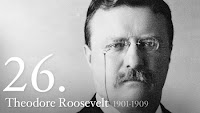 Theodore Roosevelt is credited with starting a modern renaissance of US coinage. When Roosevelt became president in 1901, he expressed his disdain for the sameness of the coinage designed by then chief engraver Charles E. Barber. Roosevelt want our coinage to reflect the greatness of the nation. He wanted a more modern classical design. Roosevelt enlisted the help of the greatest sculpture of the time, Augustus Saint Gaudens, to execute what Roosevelt called his “pet crime.”
Theodore Roosevelt is credited with starting a modern renaissance of US coinage. When Roosevelt became president in 1901, he expressed his disdain for the sameness of the coinage designed by then chief engraver Charles E. Barber. Roosevelt want our coinage to reflect the greatness of the nation. He wanted a more modern classical design. Roosevelt enlisted the help of the greatest sculpture of the time, Augustus Saint Gaudens, to execute what Roosevelt called his “pet crime.”
Duriung Roosevelt’s presidency, he was directly involved with the redesign of the gold coinage using the designs of Saint Gaudens on the eagle ($10) and double eagle ($20), Bela Lyon Pratt’s incuse design for the half-eagle ($5) and quarter eagle ($2.50) coins, and Victor David Brenner’s Lincoln Cent. The other Barber designs coin were retired by 1916.
In addition to Roosevelt’s influence on coinage, he was instrumental in growing the number of national parks and protected areas in the United States. Roosevelt, who spent a lot of time in the Badlands in the Dakota Territory influenced his view by setting aside 42 million acres of national forests, 53 national wildlife refuges, and other areas including the Grand Canyon.
Roosevelt started the program that lead to the National Wildlife Refuge system and established the US Forest Service to help maintain these natural resources.
To honor Theodore Roosevelt’s conservation work and preservation of many national parks and refuges and his “pet crime” for his redesign of US coinage, it would be fitting to honor him on the National Park Quarters. As a fan of our 28th president and his work, I have advocated that Theodore Roosevelt be honored on US coinage. If the CCAC follows through with this recommendation, it would make the National Parks Quaters more palatable.
Image of Theodore Roosevelt is from the White House website.
Feb 1, 2009 | coins, quarter
In the same manner as I acquired my first 2009 coin, I was able to obtain four DC quarters. Although I wish DC would have picked another topic, the design is not bad looking in hand.
Last year, I found my first 2008 coin in May. I am glad it did not take that long, even if it is cheating. Too bad the coin machines in the US Mint headquarters only dispense quarters and dollars!
Dec 26, 2008 | ANA, legislative, quarter
Over the last few days, I have not read many complementary reviews about the America’s Beautiful National Parks Quarter Dollar Coin Act of 2008, now Public Law Number 110-456 (GPO: Text, PDF). Not only did I write about earlier this week, but Susan Headley at About.com wrote about how many of her readers did not like the concept.
So where was the ANA? The American Numismatic Association has been representing the collector community in all matters numismatic. The ANA was instrumental in convincing congress to create the 50 State Quarters Program. The ANA does talk with congressional leaders about numismatic issues. But with very few positive things being said about what is now law, why did the ANA not say anything this time?
I am sure there will be excuse that between the holidays and that the recent burglaries of dealers that included the firm owned by ANA President Barry Stuppler may have diverted some attention from this bill. But there are others in the ANA who could be asked to speak on the community’s behalf.
One person who could have spoken on behalf of the membership is David Ganz. Ganz is a former president of the ANA, numismatic author, lawyer, and politician who worked with the ANA to lobby congress for the 50 State Quarter Program. Ganz could have spoken with Rep. Michael Castle (R-DE) and said that this is not the area to spend political capital. Rather, the Ganz could have offered to bring the idea to the ANA to allow the members to come up with fresh ideas.
When the National Parks quarters fail to capture the public attention like the 50 State Quarters, I believe the collector community will be blamed for not “being on board,” even though we were not consulted. The community will lose credibility in a manner similar to the coin shortage of the 1960’s and it will take a few years before congress will listen to the ANA again on coinage matters. It could have been avoided if the ANA would have spoken to Castle and expressed concerns when the bill was announced last June, long before the holidays!
If it is the job of the ANA to protect the hobby, the ANA failed at its job.




















